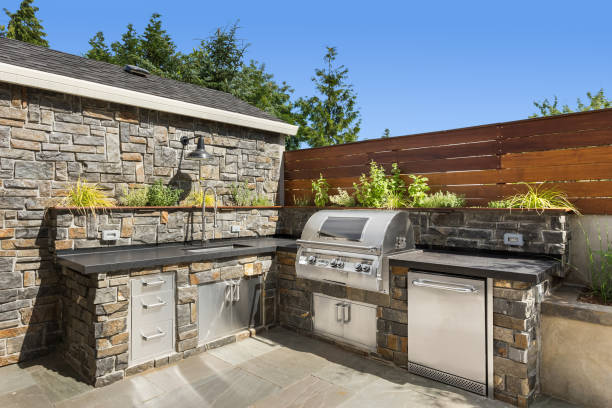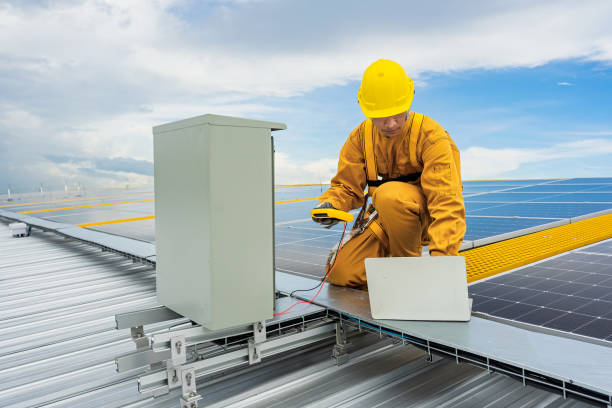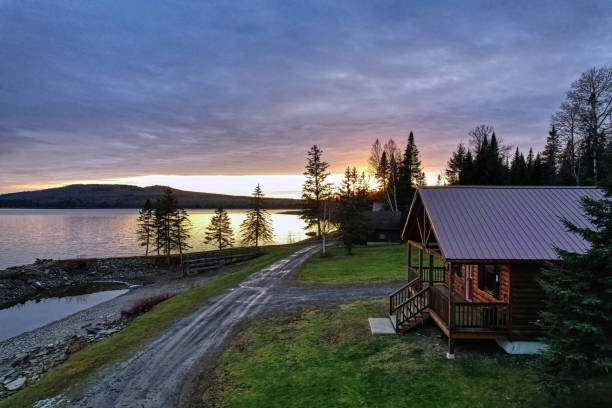10 Tips for Creating an Outdoor Kitchen
This post contains affiliate links. I may earn a commission at no extra cost to you if you make a purchase. Note that I’m not a health or outdoor safety professional, so further research is advised. Your support keeps Outdoors A-Z running—thank you! Read the full disclosure.. Read the full disclosure here.
In recent years, outdoor kitchens have become one of the most sought-after home upgrades, and it’s easy to see why. They transform an ordinary backyard into an extension of your living space, allowing you to cook, entertain, and enjoy meals without being confined indoors. Whether it’s sizzling burgers on the grill, preparing wood-fired pizza, or enjoying cocktails under the stars, an outdoor kitchen brings convenience, atmosphere, and value to your home.
But creating an outdoor kitchen requires more than simply wheeling out a barbecue and calling it a day. To design a space that is functional, durable, and enjoyable year-round, you need to think carefully about layout, appliances, materials, and overall design. With thoughtful planning, your outdoor kitchen can become a centerpiece for gatherings and a major lifestyle upgrade for your family.
Here are ten expert tips to guide you through the process of creating the perfect outdoor kitchen.
Table of Contents
Tip 1: Start With a Solid Plan
Like any major home improvement project, the success of your outdoor kitchen depends on a strong plan. Before you purchase appliances or break ground, consider how you’ll use the space. Will it be a simple grilling station for family dinners, or a fully equipped kitchen designed to entertain large groups?
Think about your budget as well as the size of your yard. A compact patio may call for a built-in grill with some counter space, while a larger backyard can accommodate more elaborate features like a pizza oven, sink, and refrigerator. Mapping out your needs and priorities in advance prevents costly mistakes and ensures that your kitchen suits both your lifestyle and your property.
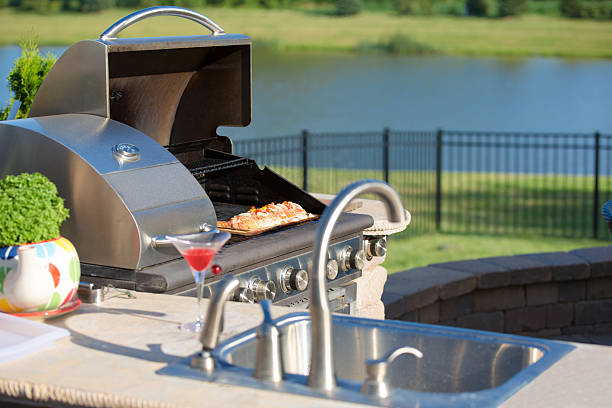
Tip 2: Choose the Right Location
The location of your outdoor kitchen is one of the most important decisions you’ll make. Ideally, it should be close to the house, particularly the indoor kitchen, so you can easily transport food, dishes, and supplies. Being near the house also makes it easier to connect utilities such as water, gas, and electricity.
At the same time, you’ll want to think about smoke direction, wind exposure, and sun patterns. Position the grill so smoke doesn’t blow directly into the dining area or into open windows. Consider whether you need shade during hot afternoons or shelter from rain. A thoughtfully chosen location ensures that your outdoor kitchen is comfortable and convenient to use throughout the year.
Tip 3: Invest in Quality Appliances
Outdoor kitchens are exposed to the elements, which means that your appliances must be able to withstand sun, rain, and fluctuating temperatures. Investing in high-quality, weather-resistant appliances will save you money and frustration in the long run.
A built-in gas or charcoal grill is often the centerpiece of an outdoor kitchen, but you may also want to add extras such as a side burner, smoker, or pizza oven depending on your cooking style. Refrigerators designed for outdoor use are especially handy, keeping drinks cold and ingredients fresh without constant trips indoors. Whatever you choose, look for appliances made from stainless steel, as it resists rust and corrosion while maintaining a sleek appearance.
Tip 4: Prioritize Durable Materials
Since your outdoor kitchen will be exposed to weather year-round, the materials you select for countertops, cabinets, and flooring must be durable. Popular choices include stone, concrete, and tile, which not only withstand outdoor conditions but also provide an upscale look. Granite and concrete countertops, for example, are both heat- and stain-resistant, making them ideal for food preparation.
Cabinetry should also be designed for outdoor use. Stainless steel cabinets are a top choice, but marine-grade polymer is another excellent option that resists moisture and fading. For flooring, look for slip-resistant surfaces such as textured stone, brick, or composite decking. By prioritizing durable materials, you ensure that your outdoor kitchen looks great and functions well for years to come.
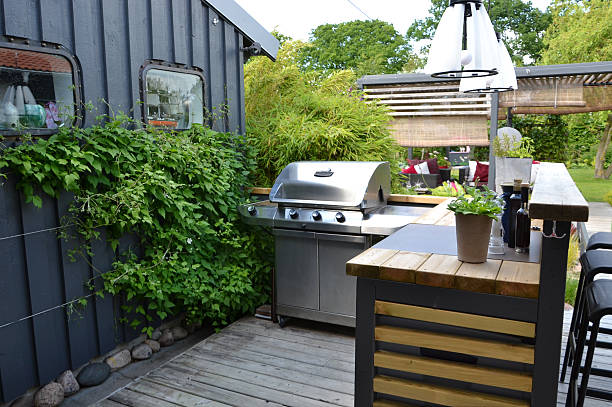
Tip 5: Design for Functionality
An outdoor kitchen should be more than beautiful; it should also be highly functional. A good rule of thumb is to follow the classic kitchen triangle—keeping the grill, sink, and refrigerator within easy reach of one another. This minimizes unnecessary steps and makes cooking outdoors as seamless as it is indoors.
Counter space is equally important. Allow enough room for food preparation, serving platters, and even a spot for guests to gather while you cook. Storage space, whether in the form of cabinets or drawers, keeps utensils, spices, and tools within reach and prevents clutter. By focusing on functionality, you’ll create an outdoor kitchen that is not only stylish but also practical.
Tip 6: Consider Climate and Weather
Your climate plays a major role in determining the design and features of your outdoor kitchen. If you live in a warm, sunny area, shading such as pergolas, umbrellas, or awnings may be essential to keep the space comfortable. In cooler regions, you might want to add a fireplace or built-in heaters to extend your outdoor cooking season.
Rain protection is also worth considering. A partial roof or retractable awning can keep your kitchen dry, protecting both you and your appliances. By designing with your local weather in mind, you’ll maximize how often you can use the space and protect your investment.
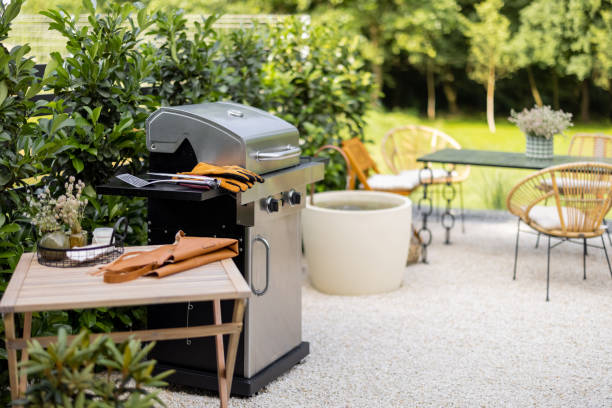
Tip 7: Add Proper Lighting
Lighting is often overlooked but is essential to both safety and ambiance. Task lighting near the grill and prep areas ensures that you can cook comfortably even after the sun goes down. Overhead lighting or pendant lights above a dining table create a welcoming environment for evening meals.
Accent lighting can take your outdoor kitchen to the next level. String lights, LED strips under counters, or solar-powered pathway lights add atmosphere while making the space safer to navigate. A well-lit outdoor kitchen not only extends your entertaining hours but also highlights the beauty of your design.
Tip 8: Think Beyond Cooking
An outdoor kitchen is not just about cooking—it’s about creating a complete outdoor living experience. Consider adding features that make the space more versatile and inviting. A built-in bar or beverage station makes it easy to serve drinks, while a fire pit or fireplace creates a cozy gathering spot once the cooking is done.
Entertainment options can also enhance your space. Outdoor speakers, a mounted weatherproof TV, or even a small stage for live music can transform your backyard into the ultimate hosting venue. By thinking beyond food, you’ll create a destination where family and friends want to spend time long after the meal is over.
Tip 9: Don’t Forget Utilities
One of the most overlooked aspects of building an outdoor kitchen is planning for utilities. Running gas, water, and electricity to your backyard requires professional installation, and it’s better to plan for this early in the process. Having proper hookups makes your kitchen more functional and reduces reliance on portable equipment.
For example, a built-in sink connected to your home’s plumbing makes cleanup much easier, while electrical outlets are essential for powering appliances, lighting, or even charging devices. Though utility installation adds to the initial cost, it pays off in convenience and usability.
Tip 10: Personalize Your Space
Finally, remember that your outdoor kitchen should reflect your style and personality. While functionality is key, the finishing touches are what make the space uniquely yours. Incorporate design elements that match the architecture of your home so the outdoor kitchen feels like a natural extension.
Decor can also add warmth and character. Choose outdoor rugs, weather-resistant cushions, or decorative planters to bring color and comfort. If you love to garden, an herb garden near your cooking station adds freshness to your meals while also serving as a natural decoration. When your outdoor kitchen reflects your lifestyle and taste, it becomes a place you’ll love to use regularly.
Final Thoughts
An outdoor kitchen is an investment in both your home and your lifestyle. By carefully planning location, materials, appliances, and functionality, you can create a space that is not only practical but also a joy to use. With the right design, it becomes much more than a cooking station—it’s a hub for connection, celebration, and relaxation.
These ten tips will guide you in creating an outdoor kitchen that balances durability, comfort, and style, ensuring that your backyard becomes the go-to gathering place for your family and friends. Whether you’re hosting a lively summer barbecue or enjoying a quiet meal under the stars, your outdoor kitchen can elevate every occasion into a memorable experience.

